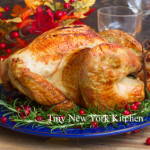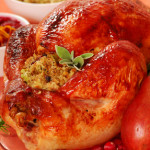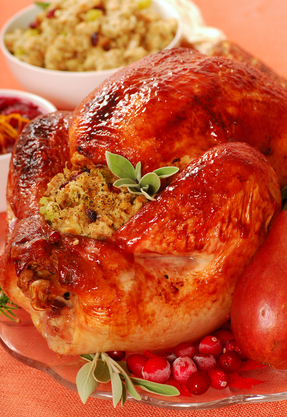Remove Turkey From Refrigerator At Least 1 Hour Prior To Roasting.
Preheat Oven To 325 Degrees.
Place Turkey In Sink And Remove Neck & Giblets.
Place In Roasting Pan And Brush With Melted Butter. Season With Salt & Pepper.
Place Turkey In Lower Third Of The Oven And Roast For 10 Minutes Per Pound.
To Determine If Turkey Is Done, Place Thermometer Between Thigh & Breast. Temperature Should Register Between 160 To 165 Degrees And Juices Should Run Clear.
When Turkey Is Done, Remove From Oven, Cover Loosely With Foil, And Allow To Rest 30 To 45 Minutes, Which Allows Time To Heat Side Dishes.
Carve & Enjoy!
Approximate Cooking Times Based On 10 Minutes Per Pound At 325 Degrees:
9 Pound Turkey: 1 1/2 To 1 3/4 Hours
12 Pound Turkey: 2 To 2 1/4 Hours
14 Pound Turkey: 2 1/4 To 2 1/2 Hours
16 Pound Turkey: 2 1/2 To 2 3/4 Hours
18 Pound Turkey: 3 To 3 1/4 Hours
20 Pound Turkey: 3 1/2 To 3 3/4 Hours
22 Pound Turkey: 4 To 4 1/4 Hours
25 Pound Turkey: 4 1/4 To 4 1/2 Hours
If You Have Stuffed Your Turkey Then Add More Time.
“Work With What You Got!”
© Victoria Hart Glavin Tiny New York Kitchen © 2016 All Rights Reserved
Making The Best Candy
Candy is not difficult to make. Some candy recipes require little or no cooking at all. Other candy recipes need only careful timing and adequate beating. For some types of candy, however, special care is necessary. Follow these basic instructions and you can become a successful and versatile candy maker.
Always read a recipe through from beginning to end BEFORE starting to cook. This is important with all recipes, but especially candy recipes. You never will know if you need special equipment or a special ingredient until you read the recipe.
Always use the best quality, freshest ingredient available.
Measure ingredients accurately, using standard measuring spoons for small amounts, a fluid measuring cup for liquids, and graduated measuring cups for dry ingredients.
Follow recipes carefully. Use only the ingredients specified and add them in the order and by the method given.
To prevent sugaring, carefully follow directions about stirring and about covering the pan.
Use moderate or low heat, according to instructions in the recipe, so the syrup does not reach the boiling point too quickly.
Always use a saucepan large enough to allow space for the candy to bubble up when boiling. A 2 quart pan is large enough in most cases, but sometimes a 3 quart or even a 4 quart pan is preferable. A pan in which candy is made should be a heavy gauge metal, which holds heat evenly and will prevent sticking.
Candy making involves a lot of stirring and beating. Although an electric mixer may be used in some stages of preparation, such as beating egg whites for divinity, for most candy mixtures a spoon is best. A long handled wooden spoon is preferable, since it will never get too hot to handle. God bless wooden spoons!
A candy thermometer that clips onto the side of the pan is almost a necessity for successful candy making, since it is critical that the candy be removed fro the heat at the moment it reaches the proper temperature. It is best to use a clearly marked, easy to read thermometer with a mercury ball that is set low enough to measure the temperature of the boiling syrup, but does not touch the bottom of the pan.
To use a candy thermometer, be sure it is at room temperature before putting it into the hot syrup. Lower the thermometer gradually into the candy mixture AFTER the sugar is dissolved and the syrup has begun to boil.
The cold-water test is an alternative to a candy thermometer. Many cooks still rely upon this test, although it is not as accurate as a candy thermometer (hard ball/soft ball).
Temperature Tests For Candy
Temperature of Syrup Test Description of Syrup When Dropped Into Very Cold Water
234° to 240 ° Soft Ball Forms a soft ball that flattens on removal from water
244° to 248° Firm Ball Forms a firm ball that does not flatten on removal from water
250° to 266° Hard Ball Forms a hard ball that, on removal from water remains hard enough to hold its shape yet pliable
270° to 290° Soft Crack Separates into threads that are hard, but not brittle, when removed from water
300° to 310° Hard Crack Separates into threads that are hard and very brittle
To water-test, use very cold, but NOT ice, water. Use a clean cup, spoon, and fresh water for each test. Remove the pan from the heat and drop a little of the hot mixture into the water. Use your fingers to gather the drops into a ball and feel its consistency. If the candy is not yet ready, immediately return the pan to the heat.
Avoid making candy on damp or rainy days. High humidity is the candy maker’s enemy. If for any reason you cannot postpone a candy making session, cook the candy 1 or 2 degrees higher on the thermometer than indicated in the recipe.
Altitude also affects candy making. Temperatures given in recipes are typically for sea level. At high altitudes the candy must be cooked about 2 degrees higher.
Be patient and always allow sufficient time. Most candy does take time to make, and there is no way to rush the cooking with disaster.
"Work With What You Got!”
© Victoria Hart Glavin Tiny New York Kitchen
Every year I tell everyone not to overcook his or her turkey and to purchase a meat thermometer AND USE IT! The objective, of course, is to have moist and juicy breast meat with succulent thighs! The turkey is the main attraction after all.
Start with a completely defrosted bird or better yet purchase an organic fresh turkey. If your turkey is frozen, however, allow 24 hours in the fridge for every 5 pounds. This is the safest way to defrost your turkey.
The turkeys of today tend to be young, moist and tender and take much less time to cook than tougher turkeys that I grew up on. If a turkey is dry, then it has been cooked too long. The breast meat is what tends to suffer the most.
A stuffed turkey may cook at the same rate as an unstuffed one, but be prepared to allow 30 to 50 minutes more. Most turkeys take about the same time to roast in regular ovens, but a convection oven does a much better job of browning the turkey all over.
When removing the turkey legs, if you find that the meat around the thigh joint is still too pink, then cut off the drumsticks from the thighs and put the thighs into a shallow pan, place in a 450 degree oven for 10 to 20 minutes until no longer pink.
Always use a meat thermometer to gauge doneness. For a stuffed turkey, use the meat thermometer to check the temperature of the stuffing. The center of the stuffing inside the turkey must reach a temperature of 165 degrees. For an unstuffed turkey, place the meat thermometer in the thickest part of the thigh, taking care that it does not touch any bone. Roast the turkey until the meat thermometer reaches 165 degrees. Don’t forget to let the turkey rest for at least 30 minutes before carving to allow the juices to re-absorb into the flesh. You do not want the moisture to drain out.
This chart will help you determine approximately how long to roast a stuffed or unstuffed turkey.
Roasting times are for a preheated 325 degrees oven:
Approximate Roasting Times For Stuffed Turkey
Turkey Weight: 6 to 8 Pounds 3 to 3 1/2 Hours
Turkey Weight: 8 to 12 Pounds 3 1/2 to 4 1/2 Hours
Turkey Weight: 12 to 16 Pounds 4 1/2 to 5 1/2 Hours
Turkey Weight: 16 to 20 Pounds 5 1/2 to 6 Hours
Turkey Weight: 20 to 24 Pounds 6 to 6 1/2 Hours
Approximate Roasting Times For Unstuffed Turkey
Turkey Weight: 6 to 8 Pounds 2 ½ to 3 Hours
Turkey Weight: 8 to 12 Pounds 3 to 4 Hours
Turkey Weight: 12 to 16 Pounds 4 to 5 Hours
Turkey Weight: 16 to 20 Pounds 5 to 5 1/2 Hours
Turkey Weight: 20 to 24 Pounds 5 1/2 to 6 Hours









